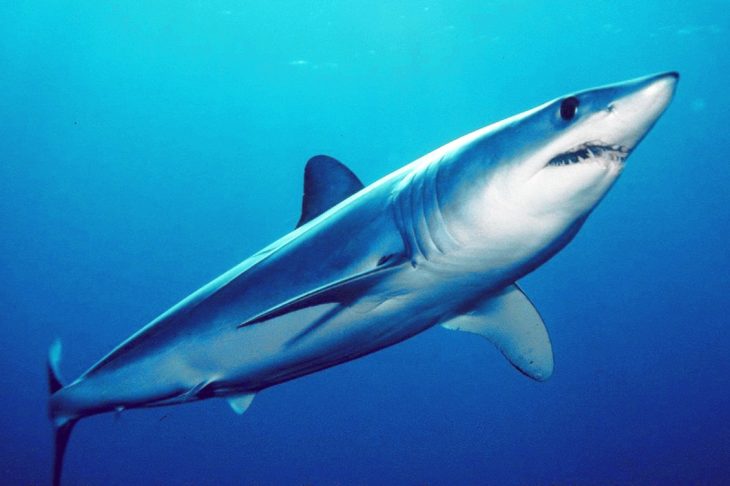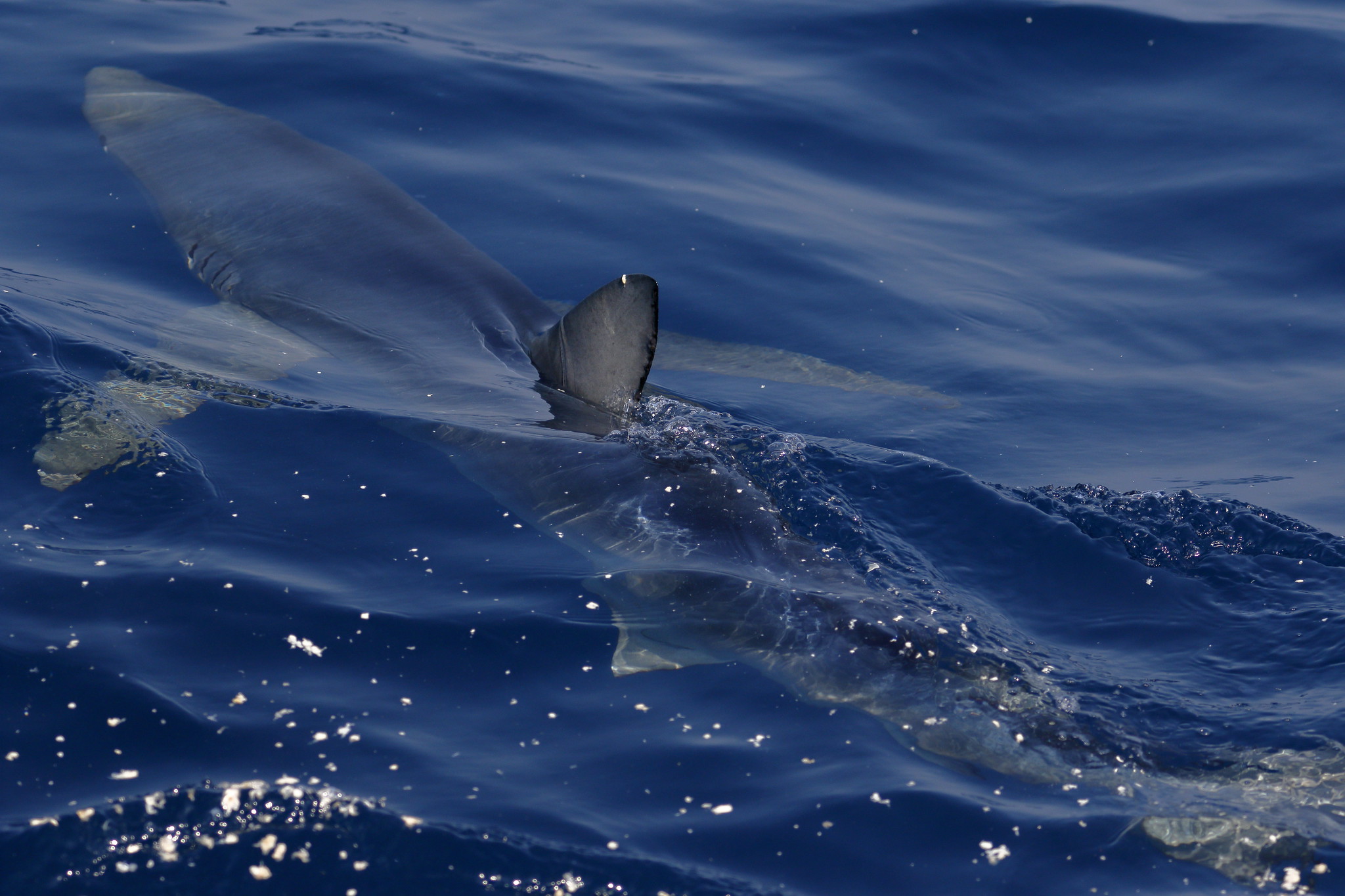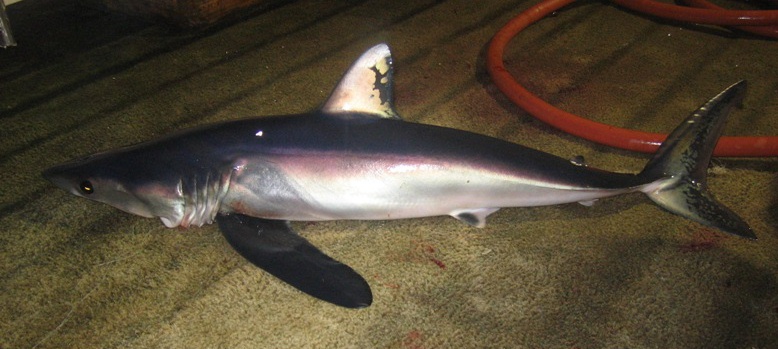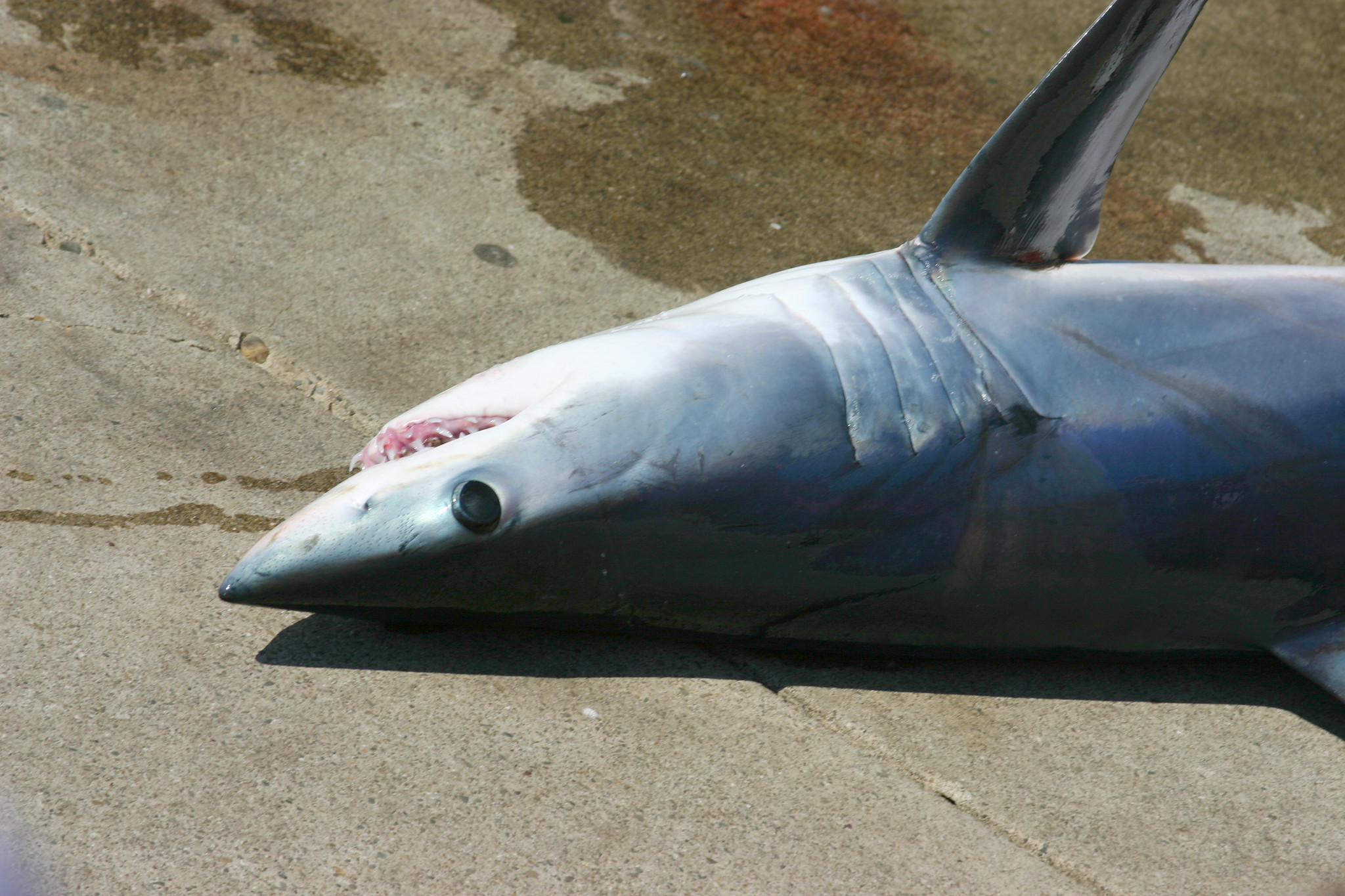
Mako sharks are large mackerel sharks closely related to great white sharks. Although they rarely ever attack humans unprovoked, the size and speed of these cunning predatory sharks often strike people with fear and awe. The shortfin mako shark is particularly famous for being the fastest shark in the vast oceans today. Learn more about these menacing animals with these mako shark facts.
- These sharks grow to around 8.2 to 14.8 ft (2.5 – 4.5 m) in length.
- Mako sharks can weigh up to 1,500 lb (680 kg).
- Mako sharks live for around 29 to 32 years, with females generally living longer than males.
- Scientists have recorded mako sharks swimming in depths of up to 2428 ft (740 m).
- A shortfin mako shark can bite with a force of up to 13,000 newtons.
- Mako sharks live in the pelagic regions of the ocean.
- Shortfin mako sharks are also called bonito sharks or blue pointers.
- Female mako sharks are typically larger than males.
- They prefer living in tropical and temperate waters.
- “Mako” originates from the Māori term for the shark or the tooth of this shark.
- There are two living species in the mako shark genus Isurus: the longfin mako shark (Isurus paucus) and the shortfin mako shark (Isurus oxyrinchus).
- Female mako sharks typically return to the same areas to give birth to their young.
- The pectoral fins of longfin mako sharks can be longer than their heads.
- Longfin mako sharks are less active swimmers than shortfin makos.
- Fossils of extinct mako shark species date back to the Cretaceous period, as old as 99.7 million years ago.
- Mako sharks gestate for about 15-19 months, around twice as long as humans.
- Shortfin mako sharks were featured in the 1999 documentary Mako: Swift, Smart & Deadly.
- Female mako sharks reach sexual maturity at around 18 years of age, while males mature at only 8 years of age.
- The species name paucus in the longfin mako’s scientific name translates to “few” in Latin.
- Remora fish often swim next to mako sharks, eating their scraps and external parasites.
The shortfin mako shark is the fastest shark in the ocean.
One of the coolest mako shark facts is that the shortfin mako swims faster than any living shark. As one of the fastest fish in the oceans, the shortfin mako can outspeed even the ferocious great white sharks. Shortfin mako sharks are capable of swimming up to 45 mph (74 km/h), while great white sharks have a top speed of 16 mph (25 km/hr). In comparison, the average human can only swim around 2 mph (3.2 km/hr).
The shortfin mako shark owes its speed to its ability to warm itself, its efficient swimming pattern, and the flexible scales around its flanks and fins. The tooth-like scales, in particular, work to greatly reduce the drag they experience as they swim through the water.
Male and female shortfin mako sharks tend to live separately.
Unlike other fish, adult males and females mako sharks rarely live together. Shortfin mako sharks often practice sexual segregation, where males and females live in separate territories according to sex. Scientists suggest that they display this behavior to prevent males from harassing females who are unwilling to mate.
That said, mating for these sharks can get quite violent. Experts say that the mako shark mating process often involves the males biting the females in various parts of their bodies.
The shortfin mako shark has a uniquely big brain.
Among all sharks that scientists have studied so far, the shortfin mako shark has the biggest brain in proportion to its body. Scientists suggest that this uniquely big brain helps them become fast learners that quickly adapt to their surroundings.
These intelligent sharks have the capacity to think critically, identifying whether humans are threats or not. They may even allow non-threatening humans to touch and feed them. Truly one of the most intriguing mako shark facts to remember!
Mako sharks travel long distances.
Violence aside, mating can be quite the journey for mako sharks when they travel extremely long distances to find a mate. During mating season, a female mako shark had been recorded to travel over 1,725 mi (2,776 km) from California to the central Pacific Ocean. On average, mako sharks swim an average of 36 mi (58 km) in a single day.
Mako sharks can leap up to 20 feet into the air.
The sheer speed of the shortfin mako shark gives it the ability to jump to great heights out of the water. Mako sharks tend to jump extremely high, reaching 20 ft (6.1 m) into the air. When caught in hooks, they often leap into the air to remove the hooks from their bodies. During these instances, they may land on boats and other ships.
Some scientists suggest that the megalodon is closely related to the mako shark.
Due to similarities in their teeth, early scientific research suggested that the closest relatives of the megalodon is the great white shark. However, most scientists now agree that the closest known relative of the megalodon is an extinct species of mako shark.
Through examining fossilized remains, experts suggest that the broad-toothed mako (Isurus hastalis) and the megalodon had a common ancestor around 4 million years ago.
They swim below their prey to avoid detection.
To catch prey, mako sharks use their speed to swiftly follow their prey from underneath. Once they get close enough, they lunge upwards, biting off the fins and flanks of their prey and preventing escape. It’s this brutal yet effective method of hunting that makes them such fearsome predators.
They have excellent camouflage due to their coloration.
Like many sharks in their family, mako sharks evolved with countershading. Their top coloration hides them within the blue waters as seen from above, while their bottom coloration helps them blend in with the sunlit ocean surface as seen from below. This countershading is effective for concealing these sharks from prey. It also helps them hide from potential predators, such as killer whales and great white sharks.

They can raise their body temperatures higher than the surrounding water.
Along with other members of the mackerel shark family, mako sharks can raise their body temperatures higher than their surrounding waters. While other sharks may struggle to swim in colder waters, mako sharks can easily swim in colder waters with temperatures as low as 41 to 51.8°F (5 – 11 °C). However, they still prefer to swim in warmer waters, typically in temperatures of 62.6 to 68 °F (17 – 20 °C).
Mako sharks can also regulate their body heat because of their specialized blood vessels. The specialized circulatory system of mako sharks and other mackerel sharks allows them to maintain body temperatures around 7 to 10 °F (4 – 7 °C) higher than the water they swim in.
Mako sharks eat a wide variety of prey.
Although bluefish (Pomatomus saltatrix) makes up a majority of the mako shark diet, these voracious sharks eat a wide variety of prey. They can eat squids, octopuses, herrings, albacore, and sea turtles. Their sheer speed and sizes even allow them to overpower dolphins and other fast swimmers such as tuna and swordfish. On average, shortfin makos eat around 3% of their weight in food in a single day, digesting their food for about two days.
Mako sharks belong to the the same family as great white sharks.
While they may have different traits, mako sharks and great whites belong to the mackerel family of Lamnidae. In fact, experts suggest that mako sharks are the closest living relatives of great white sharks. Scientists found that the extinct Hubbell’s white shark (Carcharodon carcharias) is a transitional species of great whites and mako sharks, showing characteristics of both prehistoric mako sharks and present-day great white sharks.
The longfin mako shark is the second largest species in the mackerel shark family.
Dwarfed only by the great white shark, the longfin mako shark is the second largest species in the mackerel shark family. Among the two species of mako sharks, the longfin mako sharks are larger and have longer pectoral fins than shortfin mako sharks. The largest recorded longfin mako shark was found near Pompano Beach, Florida in 1984. This longfin mako shark reached up to 14 ft (4.3 m) in length. Truly one of the most astonishing mako shark facts.

Mako sharks have good eyesight.
Unlike great white sharks, they don’t rely on electrical signals to navigate through the oceans and locate their prey. Instead, they rely on their other senses such as smell, touch, and sight. By studying and experimenting with their behaviors, scientists determined that both living species of mako sharks are mostly visual hunters.
Their eyes have millions of light-detecting cells and a tapetum lucidum similar to cats, allowing them to see well even in the dark. Mako sharks have a strong sense of smell, and their strong sense of touch also gives them the ability to detect minute pressure changes and movements in the water.
Mako sharks give birth to live young.
Like many other sharks, mako sharks do not lay eggs and instead give birth to live young. Their egg sacs develop inside their uterus, but they lack any placental connection. Around 4 to 25 shortfin mako pups develop inside the womb, born with an average length of about 27.6 in (70 cm).
For longfin mako sharks, the litter size is typically only 2, but some can have litters as large as 8. These sharks grow rather quickly immediately after birth, but it takes them years to reach reproductive maturity.
Their babies sometimes eat their underdeveloped siblings in the wombs.
Not all baby sharks survive in the womb. Although this phenomenon is rare in mako sharks and more common in other types of shark, the more developed shark fetuses within the womb may sometimes cannibalize their underdeveloped siblings.
Humans hunt mako sharks for sport.
Unfortunately, mako sharks are well-prized trophy fish. Because of the mako shark’s speed, strength, and ability to leap high up into the air, many anglers favor fishing for mako sharks. With three known mako rookeries around the world, mako shark fishing remains a popular sport.
Mako sharks are sometimes eaten as food.
When it’s not for sport, humans often hunt mako sharks for consumption. Available in many Asian markets, shark’s fin soup is one of the most popular dishes that use their meat. Compared to shortfin varieties, longfin mako sharks are said to have a poorer meat quality and are therefore often discarded or used as chum.

It’s impossible to keep mako sharks alive in captivity.
Because shortfin mako sharks are used to swimming long distances daily, it’s not surprising that they never fared well in captivity. Within the walls of aquariums, they’ve even fared poorer than great white sharks Although people have tried to keep them alive in large aquariums, the longest time a mako shark has ever lived in captivity is only five days. Even strong specimens weaken significantly in aquariums, refusing to eat, and eventually dying.
Mako sharks do not usually attack humans.
It’s no surprise that mako sharks have the capability to maim and kill humans with their sheer speed and power. However, they don’t actually attack humans all that much. Between 1580 and 2017, the International Shark Attack File only recorded a total of 9 unprovoked attacks from the shortfin mako shark. Of these incidents, only one of these attacks resulted in a fatality. In the wild, mako sharks don’t often view humans as prey and will not attack unless provoked.
Both species of mako sharks are endangered.
The International Union for Conservation of Nature (IUCN) lists both the shortfin and longfin mako sharks as endangered species. Their populations are declining mostly due to human activity, as they are often targets of hunting for food or for sport. Moreover, they’re susceptible to being bycatch or unexpectedly getting caught in fishing nets and longlines designed for catching large fish. This is definitely one of the more alarming mako shark facts.
Was this page helpful?
Our commitment to delivering trustworthy and engaging content is at the heart of what we do. Each fact on our site is contributed by real users like you, bringing a wealth of diverse insights and information. To ensure the highest standards of accuracy and reliability, our dedicated editors meticulously review each submission. This process guarantees that the facts we share are not only fascinating but also credible. Trust in our commitment to quality and authenticity as you explore and learn with us.


